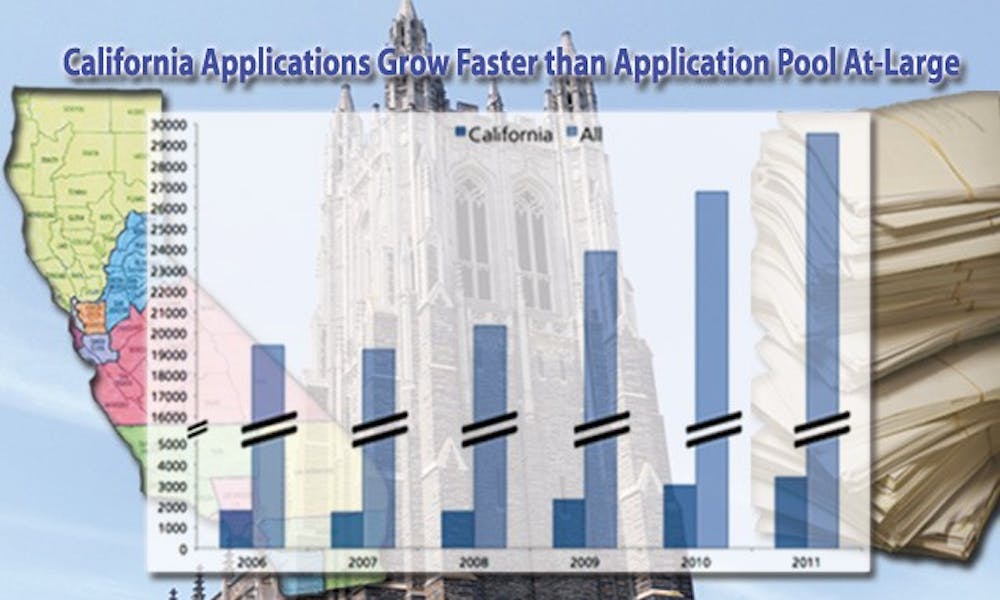An increasing number of students are trading the Golden Coast for Bull City.
Out of the 29,550 students who applied to Duke this year, 3,416 are from California, the highest number of any state by a large margin, according to Duke admissions data. The number of applications from California to Duke increased by 93 percent between 2008 and 2011. In comparison, the number of total applications increased by 45 percent.
As more Californians apply to Duke, more are matriculating as well. In 2001, 74 students enrolled at Duke—last year 149 did. This increase could be a result of a number of factors, including efforts by Duke recruiters and the California public education system’s budget crisis that has limited the financial and educational resources available to students.
“I think that part of the increase in applications from California reflects the fact that up until recently, California was underrepresented in our applicant pool, among colleges of our type,” said Dean of Undergraduate Admissions Christoph Guttentag. “Duke has risen in visibility of students from the West Coast. Part of that has been because of recruiting we’ve done and part of it is a self-perpetuating phenomenon. As mores students apply, or as students enroll, that itself increases our visibility.”
Guttentag added that the California economy may have affected some students’ decisions to come to Duke. Applicants are increasingly looking outside the state for options, while in the past they may have assumed they would be going to a University of California school, he said.
Budget shortfalls in the system have prompted significant cuts and increases in tuition. California Gov. Jerry Brown proposed cutting $1.4 billion from the state’s budget Jan. 10—$500 million each from the University of California and California State University and $400 million from the California Community College system. The next academic year may be the first time in the history of the UC system that student money would pay for more of the operating budget than the state general fund.
These budget cuts, which limit the resources California schools have available for students in the system, deterred some Duke undergraduates from staying in state. Freshman Celina Rodriguez, who is from Burbank, Calif., considered several UC schools, but in the end chose Duke for financial reasons.
“Part of the reason I came to Duke was because the UCs weren’t giving me very much financial aid, and Duke gave me more, so it was cheaper to come to Duke,” Rodriguez said.
Freshman Dawei Liu, from Fremont, Calif., was accepted to the University of California at Berkeley, the University of California at Los Angeles and the University of California at San Diego and received scholarships to all three schools. He decided to attend Duke, however, because he thought that it would offer him more educational opportunities.
“The UCs are understaffed and the resources are just not the same as they would be in a private school,” Liu said. “I’d say that budget cuts and the California economy partially affected my decision to come to Duke because they made California schools not as attractive.”
Camila McHugh, a member of the Class of 2015, said she did not consider UC schools because of their large undergraduate populations. Instead, McHugh, a current senior at Castilleja School in Palo Alto, Calif., applied to Duke and was accepted early.
For some students, growing class sizes and shrinking faculties have sparked concerns that they will not be able to enroll in classes they need for their majors, she said.
“Stories of huge classes and graduating in five years have definitely made people consider the UCs less desirable,” McHugh said.
At Duke, Rodriguez said she will be able to graduate in four years, while at the UC schools she “wasn’t guaranteed that.”
Issues for public universities extend beyond the California system. State operating support is the top issue facing public higher education in 2011, according to a policy brief by the American Association of State Colleges and Universities. Although the recession is technically over, public universities will not likely receive pre-recession revenues for another two to three years, the report noted.
To compound the problem, the stimulus funds many states have used to fund higher education will nearly run out by the end of the fiscal year. States whose higher education budgets have relied on those funds will have to find alternative sources of revenue, the report noted.
Get The Chronicle straight to your inbox
Signup for our weekly newsletter. Cancel at any time.

